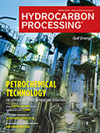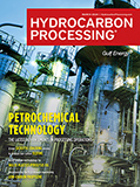Treating
Industry Perspectives: Hydrocarbon Processing honored with industry award nominations
In early September, <i>Hydrocarbon Processing</i> staff learned that the publication was nominated for several publishing awards by Folio magazine.
Diversifying the future: Incentives for worldwide adoption of renewable fuels and chemicals—Part 1
Bio-based, renewable fuels and chemicals can reduce the environmental footprint of maintaining global transportation and product demands, while also supplementing traditional fossil fuels in a global environment with increasing energy demand.
Reliability: Comparing and updating aeration blower technologies
As the main consumers of electricity in a wastewater treatment plant, aeration blowers can significantly affect the overall cost of plant operation.
Hydrocarbon Processing Awards
<i>Hydrocarbon Processing,</i> the downstream processing sector’s leading technical publication, has announced the finalists for its third annual awards.
Executive Viewpoint: Now and into the future: Challenges and solutions for the global processing industries
<i>Hydrocarbon Processing</i> sat down with senior-level executives of Merichem Company, Cyndie Fredrick (CF) and Kathy Young (KY), Senior Vice Presidents and General Managers of Merichem’s two business units, to discuss the state of the downstream industry, where it is heading in the future and how their company is helping operators meet their sustainability goals.
Editorial Comment: A shift in capital? Petrochemical projects take lead in active project market share
In mid-June, I joined Thad Pittman, Senior Research Analyst, <i>Hydrocarbon Processing’s</i> Construction Boxscore Database, to provide <i>Hydrocarbon Processing</i> subscribers with a global analysis on the downstream processing industry’s capital projects landscape.
FCC metal trap additives to process more residue
Most refiners frequently need metal trapping or bottoms cracking additives for residue operations.
Editorial Comment: The true essence of optimization
What is the first thing that comes to mind when we hear the word optimization?
Construction
Sinochem Hongrun Petrochemical Co. Ltd. will use Honeywell UOP’s ionic liquids alkylation technology to produce high-octane, cleaner-burning transportation fuels.
Business Trends: Sustainability: Clean fuels—The advancement to zero sulfur
In April, Hydrocarbon Processing launched the first iteration of its HP Sustainability webcast series.

- WestJet buys first Canadian-supplied SAF by Shell Aviation 4/23
- Technip Energies selected by Viridor to perform FEED on the Runcorn energy-from-waste carbon capture project in the UK 4/23
- SINOPEC completes its involvement in Kazakhstan's polyethylene project 4/23
- Neste premieres at Chinaplas: showcasing possibilities of bio-based and recycled materials for plastics 4/23
- Russia's oil refining near 11-month low 4/23
- Haiti fuel terminal operations halted as gangs seize trucks 4/23




